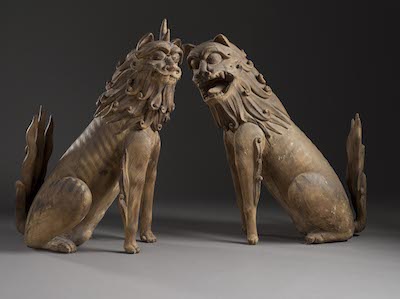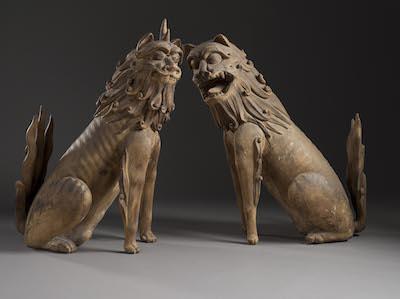A recent discovery in Kyoto, this Pair of Guardian Lions is the earliest known monumental pair of wood Japanese lion guardians in existence. Roughly 30 inches in height, and each carved from a single block of wood (probably from the same tree), they lean into each other, full of life. Pairs of Guardian Lions such as this one were originally placed in front of a Shinto shrine or Buddhist temple to protect the sacred precincts within from harm or evil spirits. They are invariably created in pairs, and then may be positioned together, or separated, flanking an entrance, gate, or building. The right lion has its mouth wide open; the left lion bares his teeth. The lion on the right is saying “ah,” the first sound of the Sanskrit alphabet; the lion on the left is saying “un,” the last sound of the Sanskrit alphabet. In English this corresponds to the saying, “from A to Z,” and in Buddhism means “all phenomena in the universe.”
 Pair of Guardian Lions, Japan, ninth century, early Heian period (794–1185), promised gift of Lynda and Stewart Resnick through the 2014 Collectors Committee, photo © 2014 Museum Associates/LACMA
Pair of Guardian Lions, Japan, ninth century, early Heian period (794–1185), promised gift of Lynda and Stewart Resnick through the 2014 Collectors Committee, photo © 2014 Museum Associates/LACMA
The heads of these lions are exaggerated in size compared to their bodies; the manes and tails are deeply and expressively carved. The tails represent stylized flames, adding the power of fire to the inherent power of the animals themselves. Even the ribs of each animal are shown in delicate carving. Original red pigment can be seen on the tongue of the right lion, and in spots of white undercoat here and there. The continuous grain of the wood can be observed even in the legs and paws of each animal. They were probably carved from the upper and lower sections of a shinboku, a sacred tree in the Japanese religion of Shinto, in which certain trees, rocks, mountains, and waterfalls are considered kami, or deities.
The astonishing early date of these sculptures—the ninth century—has been assigned to them by Professor Ito Shiro, the leading scholar of Japanese sculpture in the world today. This extremely early dating is based on three factors: the use of Japanese Nutmeg-yew (called kaya wood in Japanese, and only used between A.D. 750 and 900 for Japanese sculptures of wood); their “one-block” construction out of a single piece of hard wood (instead of the later multi-block method); and their sculptural style with its exaggerated large heads and less-muscular forelegs. The possible provenance of these National Treasure–quality artworks is being researched as this is being written: at present, all signs point to their possibly being the “lost” Guardian Lions made in the ninth century for the gatehouse of Toji, the earliest Buddhist temple of Kyoto, completed in 796. In the late 19th century, many Japanese temples sold off their artworks due to the suppression of Buddhism under the creation of what is called “State Shinto,” which emphasized the primacy of the Emperor. It is likely that our Pair of Guardian Lions left Toji, or another very early Kyoto temple of the ninth century, at this time.
The early date of these sculptures, and their incredible condition, given that they are made of wood, is hard to imagine in any culture outside of Japan. As the oldest and finest of their type in the world, including Japan, this Pair of Guardian Lions is a spectacular addition to the museum’s collection on the occasion of the 25th anniversary of the Pavilion for Japanese Art.
This Pair of Guardian Lions was acquired as a promised gift of Lynda and Stewart Resnick through the 2014 Collectors Committee.
Robert T. Singer, Curator and Department Head, Japanese Art



